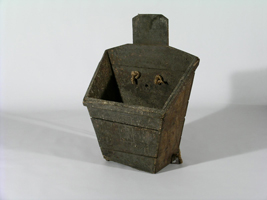Exhibition
2F Museum Facilities
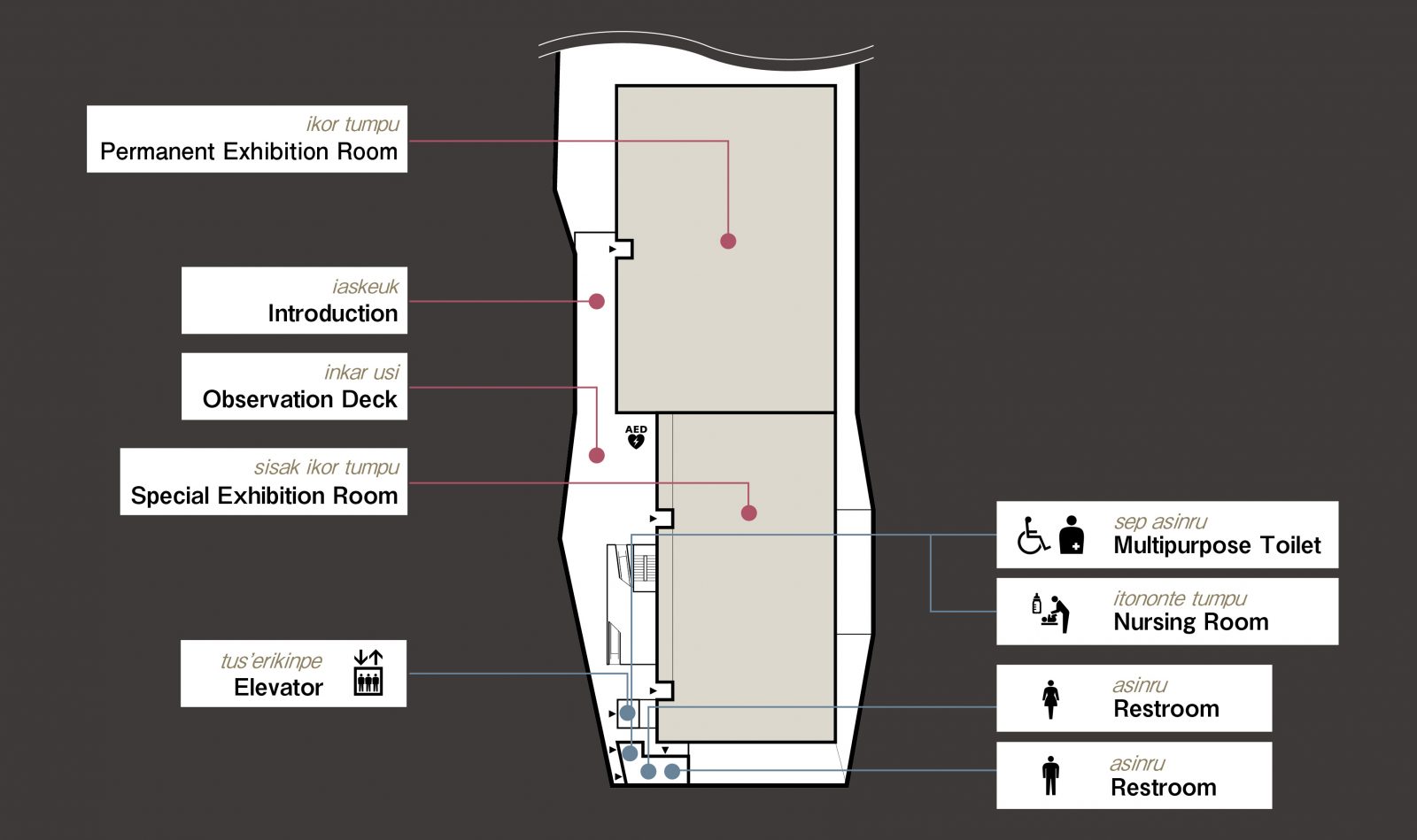
sisak ikor tumpu
Special Exhibition Room (2F)
National Ainu Museum 2nd Special Exhibition “GOLDEN KAMUY turano apkas=an ― In the footsteps of Saichi Sugimoto and Asirpa”
- Release Date:
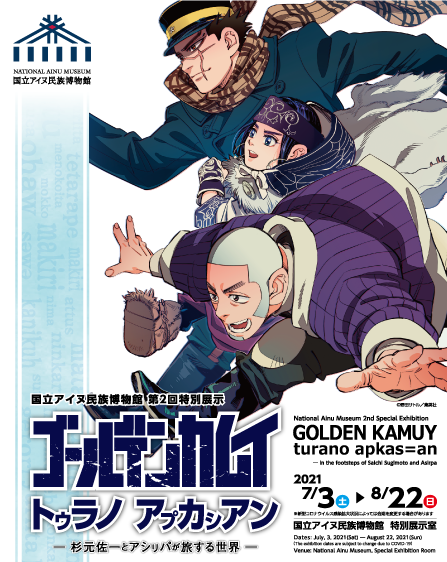
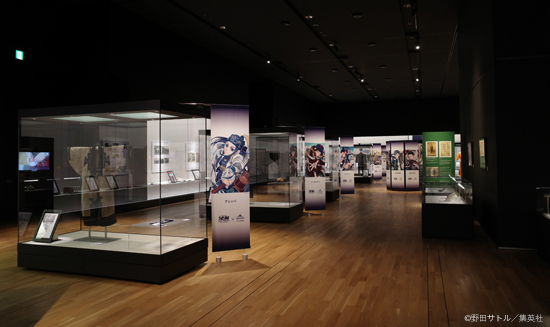
Exhibition Outline
With a focus on the original content of the bestselling manga GOLDEN KAMUY (by Satoru Noda), which has been serialized in Weekly Young Jump (Shueisha) since 2014, this exhibition explores traditional Ainu cuisine, the relationship between Ainu, animals, and plants, life in the Kotan (villages), and much more alongside the actual manga artwork and authentic folk items. The exhibition will introduce you not only to Ainu culture, but also to the other indigenous peoples who lived alongside the Ainu and appear in the manga: the Nivkh people who live in North Sakhalin, coastal areas, and the Amur river basin, and the Tungistic Uilta people. The exhibition showcases the collection of Hokkaido gold, the Ainu and the Russo-Japanese War, the culture of towns such as Otaru at the time of the manga’s setting, and the historical background behind GOLDEN KAMUY.
Set in Hokkaido and Sakhalin at the beginning of the 20th Century, and focusing on the relationship between Ainu and Wajin (ethnic Japanese), experience the culture of the indigenous Ainu people.
“Original artwork” in this special exhibition refers to printed versions of digitally drawn manuscripts.
Overview
National Ainu Museum 2nd Special Exhibition “GOLDEN KAMUY turano apkas=an — In the footsteps of Saichi Sugimoto and Asirpa”
“GOLDEN KAMUY turano apkas=an” means “walking together with GOLDEN KAMUY” in the Ainu language
- [Dates]
- July 3, 2021 (Sat) – August 22, 2021 (Sun)
- (*The exhibition dates are subject to change due to COVID-19.)
- [Closed on]
- Mondays (when Monday is a holiday, the museum will close on the next business day).
- [Venue]
- National Ainu Museum, Special Exhibition Room
- [Organized by]
- National Ainu Museum
- [Cooperation by]
- Hokkaido Government, Hokkaido Government Board of Education, and the Ainu Association of Hokkaido
- [Special Collaboration with]
- SHUEISHA Weekly Young Jump
- [Collaboration with]
- The Akan Ainu Industrial Arts Association, Asahikawa City Museum, Asahikawa City Library, Otaru Museum, The Ainu Culture Promotion Center (Sapporo Pirka Kotan), Shinhidaka Town Museum, Taiki Town Board of Education, Tohoku History Museum, Nayoro City Museum, Noboribetsu Onsen Cable Co. Noboribetsu Bear Park, Abashiri Prison Museum, Hakodate City Central Library, Nibutani Ainu Culture Museum, Hokuchin Museum, The Slavic-Eurasian Research Center (Hokkaido University), Hokkaido University Library Northern Studies Collection, Hokkaido Museum, Hokkaido Museum of Northern Peoples, Historical Village of Hokkaido
Registration and Admission
To be admitted to the Special Exhibition you will need to designate the day and time of your visit online (Advance Registration). [Online Reservation is here]
- Admission reservations for both the Permanent Exhibition and Special Exhibition can be made together online.
- In order to be readmitted to the exhibition, you will need to reserve a new admission time.
- Admission reservations are accepted from 0:00am two days in advance to 30 minutes after the start of each admission time.
COVID-19 Countermeasures: The museum is working to prevent the spread of infection based upon the guidelines of the Japanese Association of Museums.
We are continuing the reservation system for designated visit dates and times, the wearing of face masks at all times, and thorough hand disinfection.
Also you will need to pay the Upopoy Admission Fee and the Special Exhibition Fee.
- Entry to the museum is included with admission to Upopoy.
- You can buy a Special Exhibition ticket separately inside of the museum.
| Special Exhibition Fees [tax included] | + | UPOPOY Admission Fees [tax included] | |
|---|---|---|---|
| Adults | 300 yen (240 yen) | + | 1,200 yen (960 yen) / One Year Pass 2,000 yen |
| High school students | 200 yen (160 yen) | + | 600 yen (480 yen) / One Year Pass 1,000 yen |
| Junior high school students and under | Free | + | Free |
- Prices in ( ) are group discounts for 20 people or more.
- Admission is free of charge for visitors with disabilities and one caregiver. Please present documentation upon entry.
関連イベント(予定)
会期中に、中川裕氏(千葉大学名誉教授)による講演会「アイヌ文化で読み解く『ゴールデンカムイ』」(仮)ならびに研究員・学芸員による展示室解説ツアーなどを予定しております。
Contents
- 『ゴールデンカムイ』 ネコン アン ペ ネ ルウェ アン?/About GOLDEN KAMUY
- ヤウンモシㇼ ネワ コンカニ/Hokkaido and Gold
- 『ゴールデンカムイ』 オルン ウタㇻ/The Characters of GOLDEN KAMUY
- コタン オッタ エトゥナンカㇻ/An Encounter in the Kotan
- ヌチャ ウライケ ネワ ヤウンモシルンクㇽ/Hokkaido Ainu and the Russo-Japanese War
- ヤンケモシリ オㇹタ ウェーカーリ/Encounters in Sakhalin
- ヤウンモシㇼ マチヤ/The Towns of Hokkaido
⯎『ゴールデンカムイ』 ネコン アン ペ ネ ルウェ アン?/About GOLDEN KAMUY
『ゴールデンカムイ』 セコㇿ レヘ アン オルㇱペ, 野田サトル ニㇱパ ヌイェ ㇷ゚ ネ ワ アスル アㇱ ルウェ ネ.ネ オルㇱペ オッタ ヤウンモシㇼ タ アン ペ ネ チキ ヤンケモシㇼ タ アン ペ ネ チキ テエタ(明治 ケㇱ) アン ペ シンネ, 野田 ニㇱパ ヌイェ. アイヌ ウタㇻ コンカニ ポロンノ カㇻ ワ ウエカリレ コㇿカ ネン カ ウㇰ ワ ウカオ. オロワノ ウサ オカイ ウタㇻ コンカニ フナラ コㇿ ウコイキ. スギモト セコㇿ レヘ アン シサㇺ トゥミ オッタ ラメトッコㇿ クス 「ソモ ライ クㇽ」 セコㇿ アンレコレ. ネ オッカイ ネワ アシㇼパ セコㇿ レヘ アン シネ ポン メノコ コンカニ フナラ クス ピㇱカネ アㇷ゚カㇱ. 2014 パ ワノ タネ パㇰノ 『ゴールデンカムイ』 オルㇱペ 「週刊ヤングジャンプ」(集英社) セコㇿ レヘ アン カンピソㇱ カ タ アンヌイェ コㇿ アン. 2016 パ タ 野田 ニㇱパ 「漫画大賞」 アンコレ.
(The Asahikawa dialect of the Ainu language)
GOLDEN KAMUY is a manga by Noda Satoru. The story set in many locations around Hokkaido and Sakhalin at the end of the Meiji period, and centers upon a scramble to find a hidden trove of gold that was stolen from a group of Ainu. While travelling together, Sugimoto, a man who is said to be “immortal”, and Asirpa, an Ainu girl, search for the whereabouts of these gold nuggets and the secrets that they keep. Since 2014, the manga has been serialized in Weekly Young Jump (SHUEISHA). It won the Manga Taishō in 2016.

GOLDEN KAMUY © 2014 by Satoru Noda/SHUEISHA Inc.

©野田サトル/集英社
⯌ ヤウンモシㇼ ネワ コンカニ/Hokkaido and Gold
ハンケ モシㇼ タ オカ ウタㇻ カ トゥイマ モシㇼ タ オカ ウタㇻ カ ネㇷ゚ ネ ヤッカ シロカニ コンカニ タサレ ワ ウㇰ ペ ネ クス, コンカニ ヘネ シロカニ へネ カネ ネ クニ エサンニヨ. 「ゴールドラッシュ」 アリ アイェ ㇷ゚ アン ワ シロカニ コンカニ アシンノ アパ アリ ハウアㇱ コンノ コンカニ フナラ クㇽ ウウェトゥㇱマㇰ ワ ウウェカㇻパ ㇷ゚ ネ. ヤウンモシㇼ タ カ 17イㇰ ネ パ タ インネ シサㇺ, コンカニ カㇻ クㇽ ウタㇻ アㇻキ ワ ペッ オㇿ ペカ ナイ オㇿ ペカ コンカニ カㇻ クス パイェカ ワ アエレコレ カトゥ 「カニカㇻハッタㇻ」 アリ レコㇿ ウㇱケ カ ヤウンモシㇼ タ アン. ウサ 「ユリイタ」 ウサ 「カッチャ」 ウサ アエイワンケㇷ゚ アリ コンカニ アカㇻ.
(The Shizunai dialect of the Ainu language)
For a long time, people all over the world used gold and silver as the standard for their money. Gold mining booms called “Gold Rushes” occurred all over the world. In Hokkaido too, during the Edo period (17th Century), Wajin (ethnic Japanese) came from Honshu to pan for gold in the mountains. In Hokkaido, there are also Ainu language place names related to gold digging, such as Kanikar hattar (A stream pool from which gold can be gathered). Tools such as yuri-ita (traditional gold pans) and katcha (long-handled trowels) were used to find the gold.
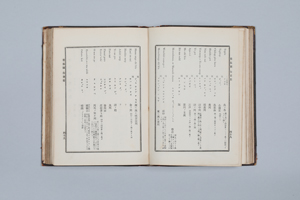
⯌『ゴールデンカムイ』 オルン ウタㇻ/The Characters of GOLDEN KAMUY
『ゴールデンカムイ』 オッタ ヤウンモシルンクㇽ, ヤンケモシルンクㇽ, シサㇺ, フレシサㇺ, ニヴフ, ウイルタ, ウサ オカイ ウタㇻ オカイ. ミピヒ ヘネ コㇿ アエイワンケㇷ゚ ヘネ 野田ニㇱパ エヤㇺノ ヌイェ ワ アン ルウェ ネ. 杉元, アシㇼパ, アイヌウタリ, 第七師団ウタリ, 土方ウタリ, ウサ オカイ 『ゴールデンカムイ』 イッケウェ ネ オカ ウタㇻ オルㇱペ チイェ コㇿ, ミピヒ ヘネ コㇿ ペ ヘネ エチヌカレアㇱ ナ.
(The Shiraoi dialect of the Ainu language)
All sorts of people, such as Hokkaido Ainu, Sakhalin Ainu, Wajin (ethnic Japanese), people from overseas, Nivkh, Uilta, and many more appear in the story. Their clothes and tools are carefully and accurately depicted. In this section we introduce the main characters of the story. Beginning with Sugimoto and Asirpa, the display includes the 7th Division of the Imperial Japanese Army and Toshizō Hijikata’s group alongside their clothing and equipment.
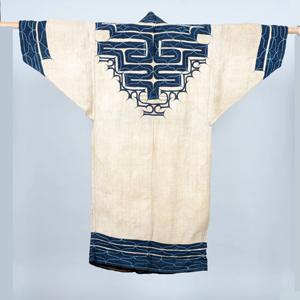
This is the model for Asirpa’s garment.
⯌ コタン オッタ エトゥナンカㇻ/An Encounter in the Kotan
杉元 シサㇺ オッカイポ ネ ワ,アシㇼパ セコㇿ アイェ アイヌ ポンメノコ エトゥナンカㇻ. 『ゴールデンカムイ』 オッタ 杉元, アシㇼパ オㇿ ワ アイヌプリ ポロンノ アエパカㇱヌ. テオロ タ ヤウンモシㇼ タ ネコン イミアン カトゥ, イペアン カトゥ, オカアン カトゥ アン ヤ セコㇿ アン ペ エチヌカレ. 『ゴールデンカムイ』 オッタ アヌイェ ㇷ゚ ネ ワ アヌココㇿ アイヌ イコロマケンル オッタ アコㇿ ストゥ カ トゥレㇷ゚タニ カ エチヌカレ.
(The Saru dialect of the Ainu language)
Asirpa, the Ainu girl that Sugimoto meets in Hokkaido. As a result of this chance meeting, there are many scenes in the manga that depict Sugimoto learning about the lifestyle of the Ainu people from Asirpa. Here we introduce the clothing, cuisine, and housing of Hokkaido Ainu. The actual sutu (punishment staff) and tureptani (tool for harvesting giant lily roots) that appear in GOLDEN KAMUY are part of our collection and are also on display.
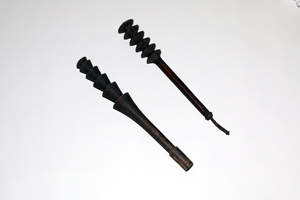
⯌ ヌチャ ウライケ ネワ ヤウンモシルンクㇽ/Hokkaido Ainu and the Russo-Japanese War
1904 パ タ 「ヌチャ ウライケ」 レヘ アン トゥミ アン.清(中国)東北 モシㇼ タ カ 朝鮮 モシㇼ タ カ シサㇺ ウタㇻ ネワ ヌチャ ウタㇻ ウライケ.
アイヌ ウタㇻ シサㇺ ネノ 「日本 オルン ウタㇻ」 ネ オカイ クス, ネ ラポキ タ シサㇺ トゥラ 63 アイヌ オッカイ ウタㇻ トゥミ オッタ モンライケ. 北風磯吉 セコㇿ レヘ アン シネ アイヌ トゥミ オッタ ラメトッコㇿ ワ アスㇽ アㇱ クス カンピ カ タ ネ オルㇱペ アンヌカㇻ. ネイ タ アナㇰネ ヤウンモシㇼ タ ネコン アイヌ オカイ ヤ, 『ゴールデンカムイ』 オッタ アヌイェ 「ヌチャ ウライケ」 ネコン アン トゥムンチ ネ ヤ セコㇿ アンペ エㇱヌカレアㇱ.
(The Nayoro dialect of the Ainu language)
The Russo-Japanese War was a war between Japan and Russia fought in northeastern Qing China and the Korean peninsula. It is said that there were 63 Ainu men who served in the Russo-Japanese War. They took part in the fighting because, by this time, they were already entered into the Japanese family register system. The exploits of one of these men, Kitakaze Isokichi from Nayoro, appeared in many books and magazines of the time. Here we introduce the Russo-Japanese War as depicted in GOLDEN KAMUY, and the Hokkaido Ainu.
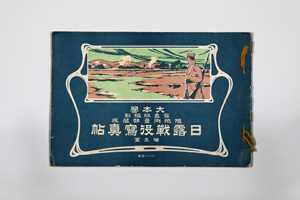
⯌ ヤンケモシリ オㇹタ ウェーカーリ/Encounters in Sakhalin
ヤンケモシリ オㇹタ 2000 パㇵノ アイヌ エピㇱカアンタ オカヤㇵシ. 1875パータ アニワモイ オㇹタ オカヤㇵシ 841 アイヌ シーサㇺ オロワ ヤウンモシリ オㇹタ アトゥㇷテㇸチ ワカイキ 1890パー パㇵノ アン パー オロワ ヤンケモシリ オㇹタ ホシピㇶチ. ヌチャ ウライケ ケセケ タ,1905パータ シーサㇺ ウライケ ウタラ ヤンケモシリ オㇹタ ヤパㇵチ イケ, ウライケ ヘマカ イレンカ アン ワ,ヤンケモシリ エンコ ネアナㇵカ シーサㇺ モシリ ネー ヘマカ. ネー ワカイキ ニヴフ ネーワ ウイルタ モシリ ネアンペ シーサㇺ ネーワ ヌチャ ウサㇵパ ウサㇵパ コロㇹチ モシリ ネー ヘマカ. タン ウタラ コタヌフ ウトゥㇷ タ 国境 シロシ ネー スマ アナマㇵチ. タン テータ ヤンケモシリ ウン アイヌ(エンチウ) ネーワ ウイルタ ネーワ ニヴフ コロ プーリ エチヌカンテアン.
(The Sakhalin dialect of the Ainu language)
Out of the approximately 2000 Sakhalin Ainu who lived in the south of the island, 841 people who lived in Aniwa Bay were moved to Hokkaido in 1875 by the Japanese government due to the Treaty of Saint Petersburg. By the end of the 1890s, the majority of this group had returned to Sakhalin. At the end of the Russo-Japanese War in July 1905, the Imperial Japanese Army occupied Russian governed Sakhalin, and according to treaty, everything below the 50th north parallel became Japanese territory. As a result of this, the regions in which the Nivkh and Uilta lived in central Sakhalin became divided by a national border and stone border markers were erected. Here we introduce the cultures of the Sakhalin Ainu, the Uilta, and the Nivkh.
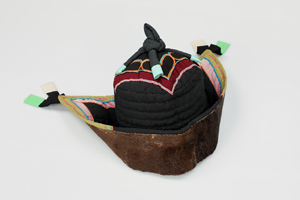
⯌ ヤウンモシㇼ マチヤ/The Towns of Hokkaido
明治 ケㇱ タ, ヤウンモシㇼ オッタ アエシㇼキラㇷ゚ ペ ポロンノ アン. 明治時代, ヤウンモシㇼ オッタ, エネ マチヤ アン ヒ, エネ インネ ウタㇻ トゥラノ オカ ヒ, ユㇷ゚ケ レラ コラチポ チウェ ルイ コラチポ ネ ワ,サモㇿモシㇼ オッタ マチヤ アコエネㇺパ アクス オアㇻオアㇻ ウウェシンナイノ オカ. ヤウンモシㇼ オルン インネ シサㇺ ウタㇻ ヤㇷ゚ ワ オヤコヤㇰタ オカ. 「お雇い外国人」 セコㇿ アイェ フレシサㇺ ウタㇻ カ ヤㇷ゚ ワ, アイヌ, シサㇺ, フレシサㇺ ウサ オカ ウタㇻ オカ ルウェ ネ. テオロ タ, 『ゴールデンカムイ』 オッタ アヌイェ マチヤ, ヘロキカㇻ, シサㇺ アエイワンケㇷ゚, エチヌカレ ナ.
(The Saru dialect of the Ainu language)
The final years of the Meiji period were a time of great change. The towns and society of Hokkaido in the Meiji period were fluid and very different from those in Honshu. At the time, many Wajin (ethnic Japanese) came to Hokkaido and lived in many areas. People from overseas known as O-yatoi Gaikokujin (hired foreigners), Ainu, Wajin (ethnic Japanese), all kinds of people from overseas, came to live in Hokkaido. Here we show the towns, herring fishing, and the everyday tools of Wajin (ethnic Japanese) depicted in GOLDEN KAMUY.
